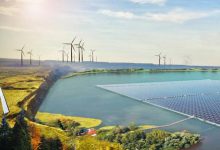Greenpeace Energy, a German electric utility that runs independent of its titular founder, has announced this week plans to buy out RWE Group’s lignite coal business and replace it with 8.2 GW worth of renewables by 2025.
The German cooperative electric utility announced its plans on Monday, revealing that it has already begun offering talks to RWE Group and other relevant stakeholders ranging from the local level to the German Government.
“What we propose is a huge chance for the Rheinische Revier – and brings us a big step forward in climate protection,” said Sönke Tangermann, CEO of Greenpeace Energy. “Our concept is financially fair for all sides and designed so that redundancies can be avoided.”
The plan was unveiled as Germany’s recently formed Coal Commission, formed to lay out a plan for the exit of the country’s remaining brown coal generators, put off its conclusions until next year. It has been struggling for solutions on financing the phase out and compensation payments.
The Greenpeace Energy plan is to gradually buy out RWE’s coal assets in the Rheinisches Revier, the Rhenish lignite mining district, over a period of five years – starting in 2020 by decommissioning the Hambach open-cast mine and the six oldest and least efficient power plant units, the Inden mine and a further six plant units in 2022, and lastly the Garzweiler mine and three final units by 2025.
“In total, the price amounts to around €384 million,” said Fabian Huneke of the Analysis Institute Energy Brainpool, who calculated the cost-effectiveness of the project.
In its place, Greenpeace Energy plans to build a total of 8.2 GW worth of renewable energy capacity – made up of 3.8 GW worth of onshore wind and 4.4 GW worth of solar PV.
These would run underneath the banner of a Citizens Energy Concept and be built on all suitable former open-case mines. In total, Greenpeace Energy expects the new renewable energy capacity to generate over 15 TWh of electricity by 2030.
Worth noting is that this would be a downgrade on the current levels of electricity generated in the Rheinische Revier, but by the early 2030s would actually represent an increaseon what the region’s coal assets would be generating.
Further, if given the green light to proceed, the renewable plant park would cost approximately €7 billion, and would be the largest such project in Europe. However, due to economies of scale, the project would be “particularly favourable to build,” according to Greenpeace Energy.
“So we can waive a remuneration under the EEG and still expect returns of between five and seven percent, based on average market values,” added Sönke Tangermann. “But above all, we can provide much more renewable electricity and more climate protection than would otherwise be possible on the basis of the EEG.”
Additionally, the project would result in 441 million fewertonnes of CO2 compared to current RWE plans, and save social costs resulting from climate damage of around €60 billion. By as early as 2020, emissions would fall by around 13 million tonnes of CO2, and by 2030 by 338 million tonnes of CO2.
The sites for the wind and solar projects would be leased by the operator cooperative from a newly-formed municipal land division which would organise all the landowners and generate lease income of €45 million annually.
The land division would also be responsible for “renaturalisation” and would contract all employees leaving the RWE lignite division through an employment company – and who would be able to work in jobs such as the “renaturation” of the open-pit surfaces, or in power plant decommissioning. Still other former coal employees would be retrained for renewable energy jobs.
“Through the citizen energy approach with the far-reaching involvement of regional actors, the concept fulfills central criteria in order to achieve the highest possible added value and job impact in the Rheinische Revier,” said Professor Dr Bernd Hirschl from the Institute for Ecological Economic Research (IÖW), a leading authority on socio-economic issues.
“The project can act as an initial spark for the transformation of this traditional energy region into an energy transition model region.”










